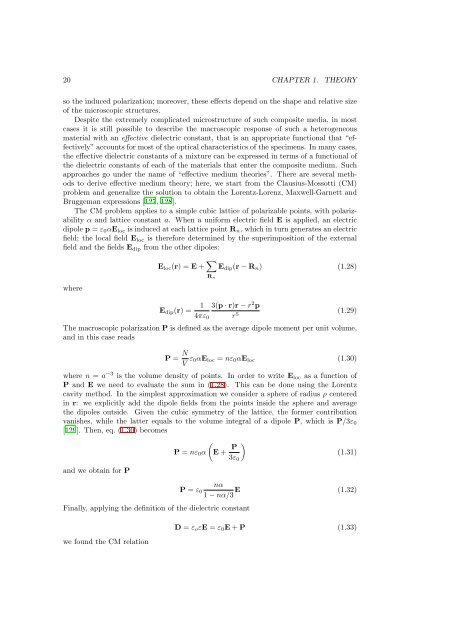Morphology and plasmonic properties of self-organized arrays of ...
Morphology and plasmonic properties of self-organized arrays of ...
Morphology and plasmonic properties of self-organized arrays of ...
Create successful ePaper yourself
Turn your PDF publications into a flip-book with our unique Google optimized e-Paper software.
20 CHAPTER 1. THEORYso the induced polarization; moreover, these effects depend on the shape <strong>and</strong> relative size<strong>of</strong> the microscopic structures.Despite the extremely complicated microstructure <strong>of</strong> such composite media, in mostcases it is still possible to describe the macroscopic response <strong>of</strong> such a heterogeneousmaterial with an effective dielectric constant, that is an appropriate functional that “effectively”accounts for most <strong>of</strong> the optical characteristics <strong>of</strong> the specimens. In many cases,the effective dielectric constants <strong>of</strong> a mixture can be expressed in terms <strong>of</strong> a functional <strong>of</strong>the dielectric constants <strong>of</strong> each <strong>of</strong> the materials that enter the composite medium. Suchapproaches go under the name <strong>of</strong> “effective medium theories”. There are several methodsto derive effective medium theory; here, we start from the Clausius-Mossotti (CM)problem <strong>and</strong> generalize the solution to obtain the Lorentz-Lorenz, Maxwell-Garnett <strong>and</strong>Bruggeman expressions [127, 128].The CM problem applies to a simple cubic lattice <strong>of</strong> polarizable points, with polarizabilityα <strong>and</strong> lattice constant a. When a uniform electric field E is applied, an electricdipole p = ε 0 αE loc is induced at each lattice point R n , which in turn generates an electricfield; the local field E loc is therefore determined by the superimposition <strong>of</strong> the externalfield <strong>and</strong> the fields E dip from the other dipoles:E loc (r) = E+ ∑ R nE dip (r−R n ) (1.28)whereE dip (r) = 14πε 03(p·r)r−r 2 pr 5 (1.29)The macroscopic polarization P is defined as the average dipole moment per unit volume,<strong>and</strong> in this case readsP = N V ε 0αE loc = nε 0 αE loc (1.30)where n = a −3 is the volume density <strong>of</strong> points. In order to write E loc as a function <strong>of</strong>P <strong>and</strong> E we need to evaluate the sum in (1.28). This can be done using the Lorentzcavity method. In the simplest approximation we consider a sphere <strong>of</strong> radius ρ centeredin r: we explicitly add the dipole fields from the points inside the sphere <strong>and</strong> averagethe dipoles outside. Given the cubic symmetry <strong>of</strong> the lattice, the former contributionvanishes, while the latter equals to the volume integral <strong>of</strong> a dipole P, which is P/3ε 0[129]. Then, eq. (1.30) becomes<strong>and</strong> we obtain for P(P = nε 0 α E+ P )3ε 0Finally, applying the definition <strong>of</strong> the dielectric constantwe found the CM relation(1.31)nαP = ε 01−nα/3 E (1.32)D = ε o εE = ε 0 E+P (1.33)
















